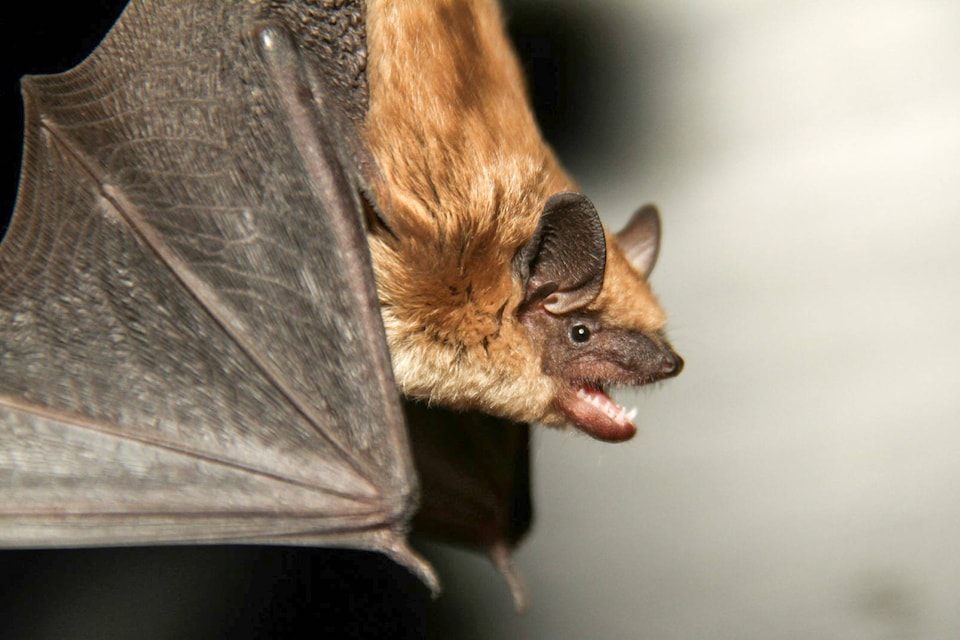If you think you���߲��о����re seeing more bats around, you���߲��о����re not alone.
According to the Okanagan Community Bat Program, mid-summer is the time when landowners notice more bat activity, even occasionally flying into a house or roosting in unusual places.
These surprise visitors are usually the young pups, according to Paula Rodriguez de la Vega, ecologist and coordinator with the bat program.
���߲��о����In July and August, pups are learning to fly and their early efforts may land them in locations where they are more likely to come in contact with humans���߲��о����, she said.
There are 16 species of bats in B.C. with 14 of them represented in the Okanagan, which Rodriguez de la Vega is the largest species diversity in Canada.
It���߲��о����s warm, it���߲��о����s dry, it���߲��о����s arid, there is lots of insects for them to eat, said Rodriguez de la Vega. However, it is hard to tell how well the bat population is doing in the valley, since there are currently no population studies being done.
���߲��о����We have been doing the annual bat counts for quite a few years and the numbers seem to be pretty stable,���߲��о���� said Rodriguez de la Vega. The bat program is also watching for the spread of white nose syndrome, an deadly fungal infection that is spreading through North American bat populations.
The fungus was reported in Washington State last year, but has yet to spread to B.C.
���߲��о����The concern is that if white nose syndrome does arrive, the bat population will likely crash,���߲��о���� said Rodriguez de la Vega.
The long spell of hot dry weather has also made bats, like humans, desperate for a drink and more likely to come out before dark to satisfy their thirst.
Female bats gather in maternity colonies in early summer, where they will remain until the pups are ready to fly. Some species of bats have adapted to live in human structures, and colonies may be found under roofs or siding, or in attics, barns, or other buildings.
Males, though, are quite solitary, according to Rodriguez de la Vega.
���߲��о����That���߲��о����s why people will find the odd bat that roosts on their deck, or in the entrance to their house for a day or two, or even a week, and then it���߲��о����s gone,���߲��о���� she said. ���߲��о����But the ones that get the most media attention are the maternity colonies, where you have the females and the pups living together.���߲��о����
, discovered when the historic Peachland Primary School was being refurbished.
���߲��о����They have about 2,000 bats living in the attic, both the Yuma Myotis and the little brown myotis, said Rodriguez de la Vega. ���߲��о����It is amazing to see them coming out at dusk, at sunset.���߲��о����
The Community Bat Program has received numerous calls reporting bats in unusual locations so far this summer. Landowners who find a bat in need of assistance or find dead bats in the Okanagan or Similkameen are asked to call a toll-free number: 1-855-9BC-BATS ext.13.
Bats in B.C. have very low levels of rabies infections, but any risk of transmission should not be treated lightly. Contact a doctor or veterinarian if a person or pet could have come into direct contact (bitten, scratched etc.) with a bat.
���߲��о����Having bats is viewed as a benefit by some landowners, who appreciate the insect control. Others may prefer to exclude the bats,���߲��о���� said Rodriguez de la Vega.
Under the B.C. Wildlife Act, it is illegal to exterminate or harm bats and exclusion can only be done in the fall and winter after it is determined that the bats are no longer in the building.
���߲��о����We offer advice and support for homeowners who are either wanting to coexist with bats or evict bats that are roosting in a building,���߲��о���� said Rodriguez de la Vega.
Ongoing education is helping people understand the benefits of having bats hanging around.
Rodriguez de la Vega said that when the bat program started, they were getting calls along the line of ���߲��о����Aie! There���߲��о����s a bat, get rid of it,���߲��о���� but now there are more calls from people just wanting to know how to be safe around bats.
To find out more and download the Seven Steps to Managing Bats in Buildings booklet, visit .
���߲��о����Depending on the situation, we have some funding to visit landowners and provide site specific advice on bat conservation and management,���߲��о���� said Rodriguez de la Vega. To contact the Okanagan Community Bat Program, call 1-855-9BC-BATS ext. 13 or email Okanagan@bcbats.ca.
The Okanagan Community Bat Program is part of the province wide B.C. Community Bat Program, funded by the Habitat Conservation Trust Foundation, the Habitat Stewardship Program and the province.



